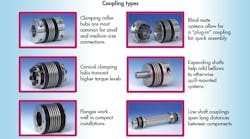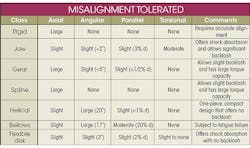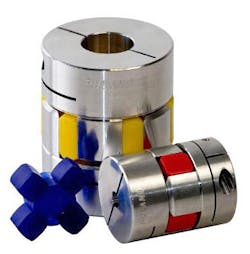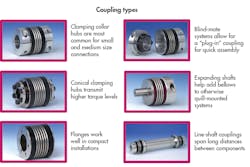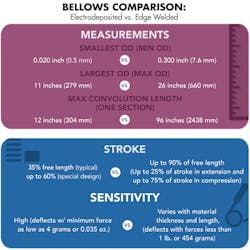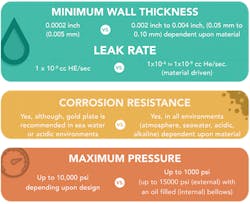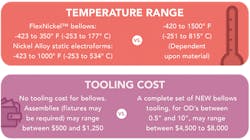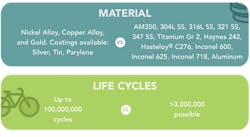What are the Differences Between Flexible Couplings?
This file type includes high-resolution graphics and schematics when applicable.
With so many types of flexible couplings on the market, designers need to understand the differences between them to ensure that they make the right selection for an application. There are six degrees of freedom (DOF) to a ridged shaft, but four DOF are of particular concern: axial, angular, parallel, and torsional.
Misalignments will cause balancing and vibration problems responsible for shutdowns. They will also greatly increase wear on multiple parts, such as the bearings. Flexible couplings can help offset the cost associated with damage or increased maintenance due to ill-aligned couplings.
Elastomeric Couplings
Using rubber or plastic materials will accommodate some misalignment while providing vibration dampening. Elastomeric types of couplings are capable of also providing shock absorption. A popular design is the jaw coupling. A metallic component goes on either end of the shafts to be connected and the elastomer fits between them.
If a jaw coupling fails, its design permits torque to continue to be transferred through the remaining metal, albeit with a lot of shaking, vibration, noise, and backlash. However, this might permit maintenance at a more convenient time, building in time to prepare for a shutdown. In addition, a keen ear, sound sensor, or vibration monitor might work as a maintenance detection device, because the vibration and noise generally increases as the elastomer breaks down. All elastomers will breakdown over time. Avoid using elastomeric couplings in environments that will expose it to high temperatures or UV light—operating in these environments will reduce the coupling’s lifecycle.
Other elastomeric couplings can stop power transmission when the materials fail. The ability to stop power transmission upon failure can protect equipment downstream, much like a rigid pin coupling. A designer can calculate a specific force that the pin should fail at, but it is more difficult with an elastomer for a few reasons. Estimating an elastomeric coupling’s precise failing load or shock can be problematic due to the changing operational and environmental conditions in varying applications. These changes affect the lifecycle and strength of the elastomer.
A similar idea to the jaw coupling is the disk coupling. The main difference is the flexible-disk coupling has little or even no backlash. Its curved jointing face may require higher machining tolerances, which can increase cost. The disk design can also reduce the shock absorption compared to the straight dental-like jointing design of the jaw coupling. The Disk design may be more difficult to assemble. Multiple disks need to align. Other designs, such as the jaw coupling, are often a single piece. These properties might lead to using disk couplings where lower loads and precision are more important.
Lubricated/Non-Lubricated Couplings
Other flexible couplings, called lubricated couplings: gear grid and chain. These designs rely on a tolerance allowance to compensate for misalignment. For example, a roller chain connecting two shafts allow for some movement or slack in the assembly, which occurs naturally from the tolerances between components of the chain.
This type of coupling, specifically the flexible gear design, is known for having the ability to transmit large loads. Unfortunately, they can also be costly and typically require more maintenance, as these couplings must have proper lubrication. Such lubricated couplings may not work well in hazardous or wash down environments.
Non-lubricated couplings include disk, diaphragm, link, spiral wound, bellows, and beam coupling types. If these couplings stay within the design properties, they theoretically can have an infinite life. Some are complex, and therefore tend to be expensive. However, when compared to the costs associated with premature or fatigue failure brought on by a misalignment, the additional cost can be justified.
Bellow Couplings
Flexible couplings are generally two hubs connected by a compliant member. The compliant member can be an elastomer and even some soft or springy metal. Bellow couplings represent one type of flexible metal coupling. They come in three types: formed, electroplated, and edge-welded.
Bellow couplings resist axial, parallel, and angular misalignment. Their design can be costly, though, and not necessarily be able to handle greater misalignments than elastomeric or other flexible couplings. Such couplings can account for misalignment while adding little to no residual stress on the connecting shaft.
Bellows can be designed for a theoretically infinite life. Servometer published that electroplated bellows can handle up to 100 million cycles, and edge-welded bellows will survive over 3 million cycles. Edge-welded bellows differ from their electroplated counterparts in their ability to handle larger outer diameters of shafts and greater lengths between shafts. In addition, edge-welded bellows offer a wider range in materials, and can be cheaper in startup tool cost. However, depending on the volume, both formed and electroplated bellows can be competitive price-wise despite startup tool cost.
Other differences between electroplated and formed bellows include tolerance in wall thicknesses and material selection. Electroplating can offer more consistent wall thicknesses at 25 µm or less. This allows electroformed bellows to be used for sensitive precise applications that require an exacting coupling. The different processes will inherently lend themselves to different materials. For example, metals with a high modulus of elasticity may not form easily and might better lend themselves to electroplating.
Looking for parts? Go to SourceESB.
